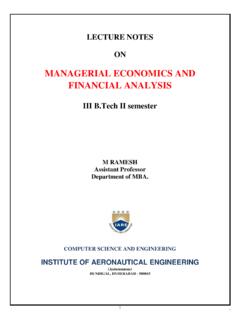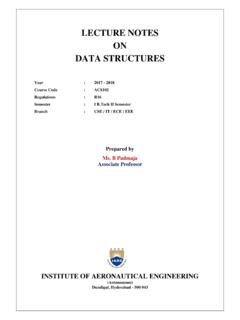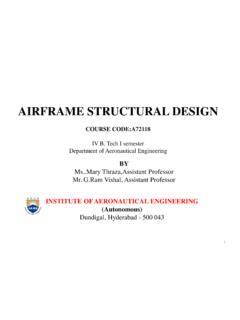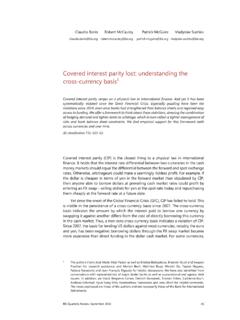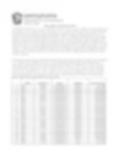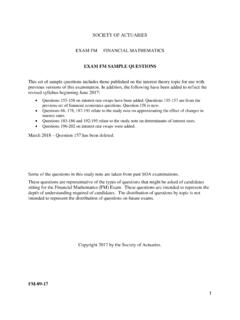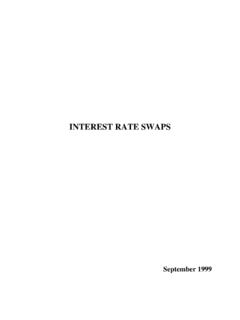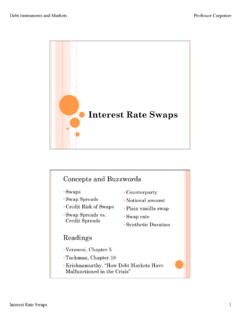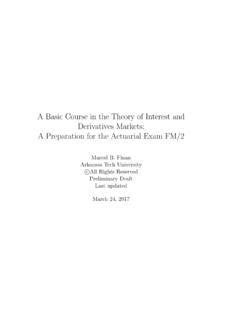Transcription of FINANCIAL DERIVATIVES
1 LECTURE NOTES ON FINANCIAL DERIVATIVES MBA IV SEMESTER (IARE R16) Prepared by Mr. M Ramesh Assistant Professor, Department of MBA DEPARTMENT OF MASTER OF BUSINESS ADMINISTRATION INSTITUTE OF AERONAUTICAL ENGINEERING (Autonomous) Dundigal, Hyderabad 500 043 SYLLABUS UNIT- I: INTRODUCTION TO DERIVATIVES Development and growth of derivative markets, types of DERIVATIVES uses of DERIVATIVES , fundamental linkages between spot & derivative markets, the role of DERIVATIVES market, uses and misuses of DERIVATIVES . UNIT-II: FUTURE AND FORWARD MARKET Structure of forward and future markets, mechanics of future markets hedging strategies, using futures, determination of forward and future prices, interest rate futures currency futures and forwards. UNIT-III: BASIC OPTION STRATEGIES Options, distinguish between options and futures, structure of options market, principles of option pricing.
2 Option pricing models: the binomial model, the Black-Scholes Merton model. Basic option strategies, advanced option strategies, trading with options, hedging with options, currency options. UNIT-IV: COMMODITY MARKET DERIVATIVES Introduction, types, commodity futures and options, swaps commodity exchanges multi commodity exchange, national commodity derivative exchange role, functions and trading. UNIT-V: swaps Concept and nature, evolution of swap market, features of swaps , major types of swaps , interest rate swaps , currency swaps , commodity swaps , equity index swaps , credit risk in swaps , credit swaps , using swaps to manage risk, pricing and valuing swaps . Unit-I INTRODUCTION TO DERIVATIVES \ DERIVATIVE MARKET One of the key features of FINANCIAL markets are extreme volatility.
3 Prices of foreign currencies, petroleum and other commodities, equity shares and instruments fluctuate all the time, and poses a significant risk to those whose businesses are linked to such fluctuating prices . To reduce this risk, modern finance provides a method called hedging. DERIVATIVES are widely used for hedging. Of course, some people use it to speculate as well although in India such speculation is prohibited. DERIVATIVES are products whose value is derived from one or more basic variables called underlying assets or base . In simpler form, DERIVATIVES are FINANCIAL security such as an option or future whose value is derived in part from the value and characteristics of another an underlying asset. The primary objectives of any investor are to bring an element of certainty to returns and minimize risks. DERIVATIVES are contracts that originated from the need to limit risk.
4 Derivative contracts can be standardized and traded on the stock exchange. Such DERIVATIVES are called exchange-traded DERIVATIVES . Or they can be customized as per the needs of the user by negotiating with the other party involved. Such DERIVATIVES are called over-the-counter (OTC) DERIVATIVES . A Derivative includes: (a) a security derived from a debt instrument, share, loan, whether secured or unsecured, risk instrument or contract for differences or any other form of security ; (b) a contract which derives its value from the prices, or index of prices, of underlying securities. Advantages of DERIVATIVES : 1. They help in transferring risks from risk adverse people to risk oriented people. 2. They help in the discovery of future as well as current prices. 3. They catalyze entrepreneurial activity. 4. They increase the volume traded in markets because of participation of risk adverse people in greater numbers.
5 5. They increase savings and investment in the long run. TYPES OF DERIVATIVE INSTRUMENTS: Derivative contracts are of several types. The most common types are forwards, futures, options and swap. Forward Contracts A forward contract is an agreement between two parties a buyer and a seller to purchase or sell something at a later date at a price agreed upon today. Forward contracts, sometimes called forward commitments, are very common in everyone life. Any type of contractual agreement that calls for the future purchase of a good or service at a price agreed upon today and without the right of cancellation is a forward contract. Future Contracts A futures contract is an agreement between two parties a buyer and a seller to buy or sell something at a future date. The contact trades on a futures exchange and is subject to a daily settlement procedure. Future contracts evolved out of forward contracts and possess many of the same characteristics.
6 Unlike forward contracts, futures contracts trade on organized exchanges, called future markets. Future contacts also differ from forward contacts in that they are subject to a daily settlement procedure. In the daily settlement, investors who incur losses pay them every day to investors who make profits. Options Contracts Options are of two types calls and puts. Calls give the buyer the right but not the obligation to buy a given quantity of the underlying asset, at a given price on or before a given future date. Puts give the buyer the right, but not the obligation to sell a given quantity of the underlying asset at a given price on or before a given date. swaps swaps are private agreements between two parties to exchange cash flows in the future according to a prearranged formula. They can be regarded as portfolios of forward contracts. The two commonly used swaps are interest rate swaps and currency swaps .
7 1. interest rate swaps : These involve swapping only the interest related cash flows between the parties in the same currency. 2. Currency swaps : These entail swapping both principal and interest between the parties, with the cash flows in one direction being in a different currency than those in the opposite direction. SEBI Guidelines: SEBI has laid the eligibility conditions for Derivative Exchange/Segment and its Clearing Corporation/House to ensure that Derivative Exchange/Segment and Clearing Corporation/House provide a transparent trading environment, safety and integrity and provide facilities for redressal of investor grievances. Some of the important eligibility conditions are : 1. Derivative trading to take place through an on-line screen based Trading System. 2. The DERIVATIVES Exchange/Segment shall have on-line surveillance capability to monitor positions, prices, and volumes on a real time basis so as to deter market manipulation.
8 3. The DERIVATIVES Exchange/ Segment should have arrangements for dissemination of information about trades, quantities and quotes on a real time basis through at least two information vending networks, which are easily accessible to investors across the country. 4. The DERIVATIVES Exchange/Segment should have arbitration and investor grievances redressal mechanism operative from all the four areas/regions of the country. 5. The DERIVATIVES Exchange/Segment should have satisfactory system of monitoring investor complaints and preventing irregularities in trading. 6. The Derivative Segment of the Exchange would have a separate Investor Protection Fund. 7. The Clearing Corporation/House shall perform full novation, , the Clearing Corporation/House shall interpose itself between both legs of every trade, becoming the legal counterparty to both or alternatively should provide an unconditional guarantee for settlement of all trades.
9 8. The Clearing Corporation/House shall have the capacity to monitor the overall position of Members across both DERIVATIVES market and the underlying securities market for those Members who are participating in both. 9. The level of initial margin on Index Futures Contracts shall be related to the risk of loss on the position. The concept of value-at-risk shall be used in calculating required level of initial margins. The initial margins should be large enough to cover the one-day loss that can be encountered on the position on 99 per cent of the days. 10. The Clearing Corporation/House shall establish facilities for electronic funds transfer (EFT) for swift movement of margin payments. 11. In the event of a Member defaulting in meeting its liabilities, the Clearing Corporation/House shall transfer client positions and assets to another solvent Member or close-out all open positions.
10 12. The Clearing Corporation/House should have capabilities to segregate initial margins deposited by Clearing Members for trades on their own account and on account of his client. The Clearing Corporation/House shall hold the clients margin money in trust for the client purposes only and should not allow its diversion for any other purpose. 13. The Clearing Corporation/House shall have a separate Trade Guarantee Fund for the trades executed on Derivative Exchange/Segment. SEBI has specified measures to enhance protection of the rights of investors in the Derivative Market. These measures are as follows: 1. Investor s money has to be kept separate at all levels and is permitted to be used only against the liability of the Investor and is not available to the trading member or clearing member or even any other investor. 2. The Trading Member is required to provide every investor with a risk disclosure document which will disclose the risks associated with the DERIVATIVES trading so that investors can take a conscious decision to trade in DERIVATIVES .


